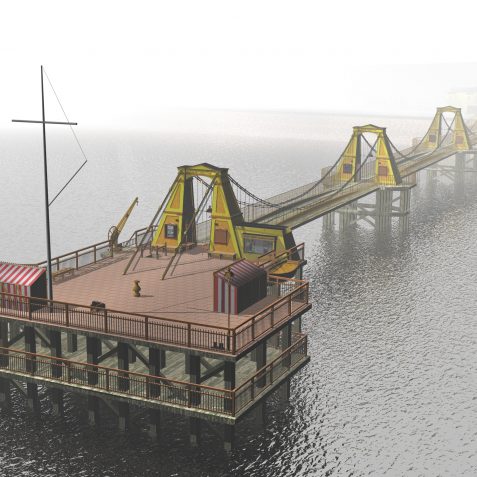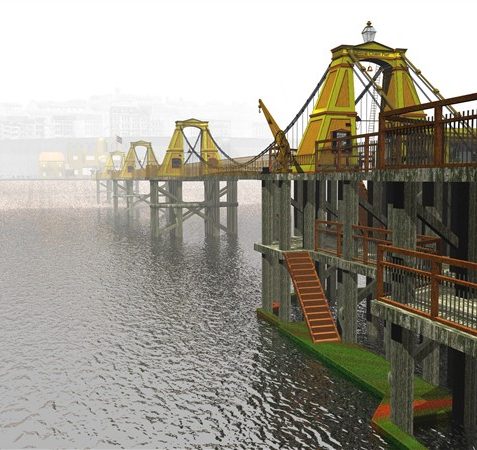Computer generated model
Computer generated image
Produced by Jean Hopkins
Computer generated image
Produced by Jean Hopkins
Computer generated image
Produced by Jean Hopkins
Since arriving in Brighton I have been fascinated by the classic structure of the Chain Pier. I was surprised to find generally there is nothing on the seafront to indicate its important position in Brighton history.
Over the years I was inspired to produce a computer generated model of this important landmark. It seems to me that there is a general apathy that threatens to allow developers to destroy what little of Brighton heritage that remains.







Comments about this page
Jean, There used to be a plaque on the wall to mark where it used to be but it has been taken down over the last few years and hasn’t been replaced. There’s nothing to remember it by other than the cannon on the Palace Pier and the two kiosks now on the Palace Pier. I know I’ve told you already, but your images are fantastic.
Wouldn’t it be nice to have the wreck of our West Pier replaced by a structure as above? That’s a brilliant image.
I’ve now put a very basic 3D model on Google Earth which puts the pier in its correct position. All comments welcome.
What fantastic images! They really bring the vanished past to life. Thank you for adding these to the site.
Hi Jean, I’ve been on Google Earth but I cannot see your model. How do I find it?
Download the model from under Royal Chain Pier: http://sketchup.google.com/3dwarehouse. Open Google Earth and click on ‘3d buildings’ and hopefully it will show it on the view of Brighton. Sorry for the delay in getting back to you.
I have a water colour painting of 1876 by W.Charles depicting Brighton beach, the Royal Suspension Chain Pier, fishing boats & fishermen with their nets. I believe the Palace Pier was built on the same site as the Chain Pier.
Hi Jean, I have just chanced on your web page about the Brighton Chain Pier. My G-G-Grandfather was Edward Haines who was a ‘Profilist’ or ‘Scissorgraphist’ who cut silhouettes in one of the booths at the pier’s entrance, he also ran pleasure boats from the eastern entrance of the pier(?) and his father, also Edward, owned the Camera Obscura and a (I believe) toyshop. I have such information as the family’s addresses in Brighton up to the 1860s when Edward died. His widow appears in London in the 1871 census. With your interest in the Chain Pier I wonder if you know of any local sources of information that might tell me more about Edward and his family. He has an entry in Jackson’s ‘SILHOUETTES: A History and Dictionary of Artists’ [741.7 JAC]. That entry also refers to a “Bishop, writing of the Chain Pier in 1897 writes … ” Have you come across this ‘Bishop’? Best Regards
The pier’s foundations are above the Madeira cafe/seagull restaurant - best viewed on Max Miller walk (1930s), which has a plaque 10 yards west, now reinstated. The height of Max Miller walk is where the roof of the Bazare was and where the Camara Obscura was situated. If you look up to the railings on Marine Parade you can still see a single gate where people had access to the roof and Obscura. The book A visit to the Regent Iron and Brass foundery (Elizabeth Sandman), describing a visit and describing castings being made of the towers, is well described and can now be found on Google books.
In September 2010 the Mayor of Brighton & Hove unveiled a plaque commemorating the Chain Pier. It’s an almost exact replica of the original plaque that went missing some years ago and was jointly funded by Brighton & Hove Council and the Max Miller Appreciation Society.
Fantastic images. I hope you can produce more of Brighton’s lost treasures, i.e. West Pier, Volks Daddy Long Legs Railway, etc.
The foundations on the sea bed can still be seen if you look on a day where there is a very low Spring tide and the water is very calm and clear.
If you go on http://www.bing.com/maps/ and focus in on Brighton just to the east of Brighton Pier using satellite image, you can see the foundations of the end landing stage. If you look carefully you can just about see the position of the next support column too. It looks like the foundations are mussel beds now as they are quite dark, the other column foundations are now covered by pebbles.
Last year I was very lucky to see the remains of the Chain Pier at low tide. I could even see the tops of the second and third columns. I went back this year to try and capture them again at very low tide but they had all been covered over with sand! Sure they’ll appear again soon!
Jean, I tried to email you but have lost your address since I last emailed you a few years ago. I went to see the sundial that was from the Chain Pier today. Am wondering why it is where it is? I wonder if you know? Would you mind emailing me at carolhomewood@sky.com Many thanks.
Hi Jean, I had the same idea and started building the pier in 3D Studio Max, this was in winter 2006-2007 (I moved to Brighton in 2005). I lost interest before I finished, mostly due to rendering times etc. I’ve only just joined this site, I’ll see if I can display an example of my work. I’m interested to know if you carried on with your work.
Hi Mike,
I’ve been off-line for a while now and cannot remember my log-in details. Sorry for not replying to your message. It would be good to share what work we have both done Please email me at seaminx@Hotmail.com
[Jean, you have successfully posted a comment so I am not sure what log-in details you require. Comments Ed]
I own the balcony flat in Chain Pier House – 48 Marine Parade and it’s great to look out on the view Sir Samuel Brown would have looked out on. Does anyone now what happened to him after the pier broke up? Did he just continue his work, or was his reputation damaged?
I think Samuel Brown, R.N., F.R.S.E., died in 1852 – well before the demise of Brighton’s Royal Suspension Chain Pier. Like his wonderful pier, he reached a little beyond three score years and ten!
Samuel Brown died in 1852 and the Chain Pier collapsed in a storm in December 1896. Not sure if that answers the last question?
He built up his reputation long before he built the Chain Pier, firstly in the navy from 1795 until 1811. Then later his reputation as an engineer and inventor was established, improving chain cables and suspension bridges. He patented many of his inventions, mainly relating to marine engineering. He died in 1852, so his pier outlived him by many years, and considering it was the very first pier and lasted almost 75 years, his reputation was not affected at all. You are correct that during the construction of the pier, which took less than 12 months, he lived at 48 Marine Parade.
Hi
I am replying to a comment left on this page in 2010 by Mike Null Munson.Although it was awhile ago I hope that he may pick up on this comment.I am researching for my friend who is the Great Great Greatgrandaughter of Edward Haines.I have a lot of info on his son Harry Haines and siblings.
Heres hoping!
Hi. Could you get in touch with me please? I am an artist doing a masters in architectural and urban design at the university of Brighton. I am working on a project involving the pier and wonder if I might be able to use your model? (www.mattreedartist.com)
I also have a watercoloured picture of the old Chain Pier from the landing stage end purchased in Brighton many years ago, artist unknown.
Captain Samuel Brown was also responsible for the building of the Union Chain Bridge across the River Tees at Horncliffe Northumberland which opened in 1820. Photographs of this can be found on the ‘net as I can’t seem to post mine here.
Add a comment about this page